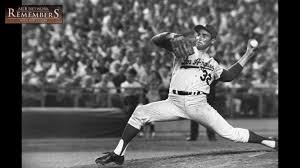In the storied history of baseball, some players are remembered for their stats, some for their impact, and a rare few for how they changed the very soul of the sport. Sandy Koufax belongs in that final, most exclusive category. A dominant left-handed pitcher for the Brooklyn and Los Angeles Dodgers from 1955 to 1966, Koufax not only mesmerized fans with his blazing fastball and devastating curve but also redefined what it meant to be an athlete with integrity, poise, and power.
From Potential to Phenomenon
Koufax’s rise wasn’t immediate. Signed by the Dodgers at just 19 years old, he was viewed as a raw talent with immense potential. His first several seasons were inconsistent, plagued by control issues and mechanical inconsistency. At one point, it looked like he might never fulfill the hype.
But then, something changed. In 1961, Koufax unlocked his control, and with it came one of the most dominant pitching stretches in baseball history. From 1961 to 1966, he compiled a record of 129–47, led the National League in ERA five times, and struck out more than 300 batters in three different seasons.
Perhaps his 1965 season best captures his brilliance. That year, he went 26–8 with a 2.04 ERA, threw his fourth no-hitter (including a perfect game), and struck out a then-record 382 batters. He did all this while battling chronic arthritis in his left elbow, often pitching in pain so intense that he had to wrap his arm in ice for hours after games.
A New Standard for Pitching Excellence
Before Koufax, pitchers were often measured by wins and innings pitched. Koufax introduced a new standard dominance per inning, the ability to not just get outs, but to overwhelm hitters. His fastball exploded out of his hand with late life, and his curveball had such a sharp break that hitters often swung before it had dropped into the strike zone.
Teammates and opponents alike described his starts as events. Stadiums would fill just to watch him work. Hall of Famer Willie Stargell once said, “Trying to hit Koufax was like drinking coffee with a fork.”
He wasn’t just good he was terrifying. At his peak, Sandy Koufax made baseball look unfair.
More Than a Pitcher: A Man of Principle
Koufax’s greatness extended beyond the diamond. During the 1965 World Series, he famously refused to pitch Game 1 because it fell on Yom Kippur, the most sacred day in Judaism. It was a decision that made headlines, but more importantly, it made a statement: faith and identity matter, even on the biggest stage in sports.
In an era when athletes were expected to conform and stay silent, Koufax quietly asserted his values, setting a powerful example for future generations of sports figures who would speak out for causes they believed in.
A Legacy Secured in Just 12 Seasons
Despite playing only 12 seasons retiring at the age of 30 due to the relentless pain in his arm Koufax’s impact was so immense that he was inducted into the Baseball Hall of Fame just six years later, becoming the youngest player ever honored at that time.
His early retirement only enhanced his mystique. He left the game at his absolute peak, with a perfect game, three Cy Young Awards, and a World Series MVP under his belt. He didn’t decline he vanished like a mythic figure, leaving fans wondering just how much more he could have done.
The Enduring Impact of a Legend
Today, Sandy Koufax is more than a name in a record book. He is baseball royalty, an enduring symbol of what it means to pursue excellence with dignity. In a sport that reveres history, Koufax’s story is passed down like legend a tale of a man who could make a ball dance, who pitched through pain, and who stood firm in his beliefs.
Koufax didn’t just play baseball; he elevated it. He changed how pitchers prepared, how fans watched, and how greatness is defined. Every flame-throwing lefty chasing dominance on the mound today walks in the footsteps of a man who redefined what the game could be.

